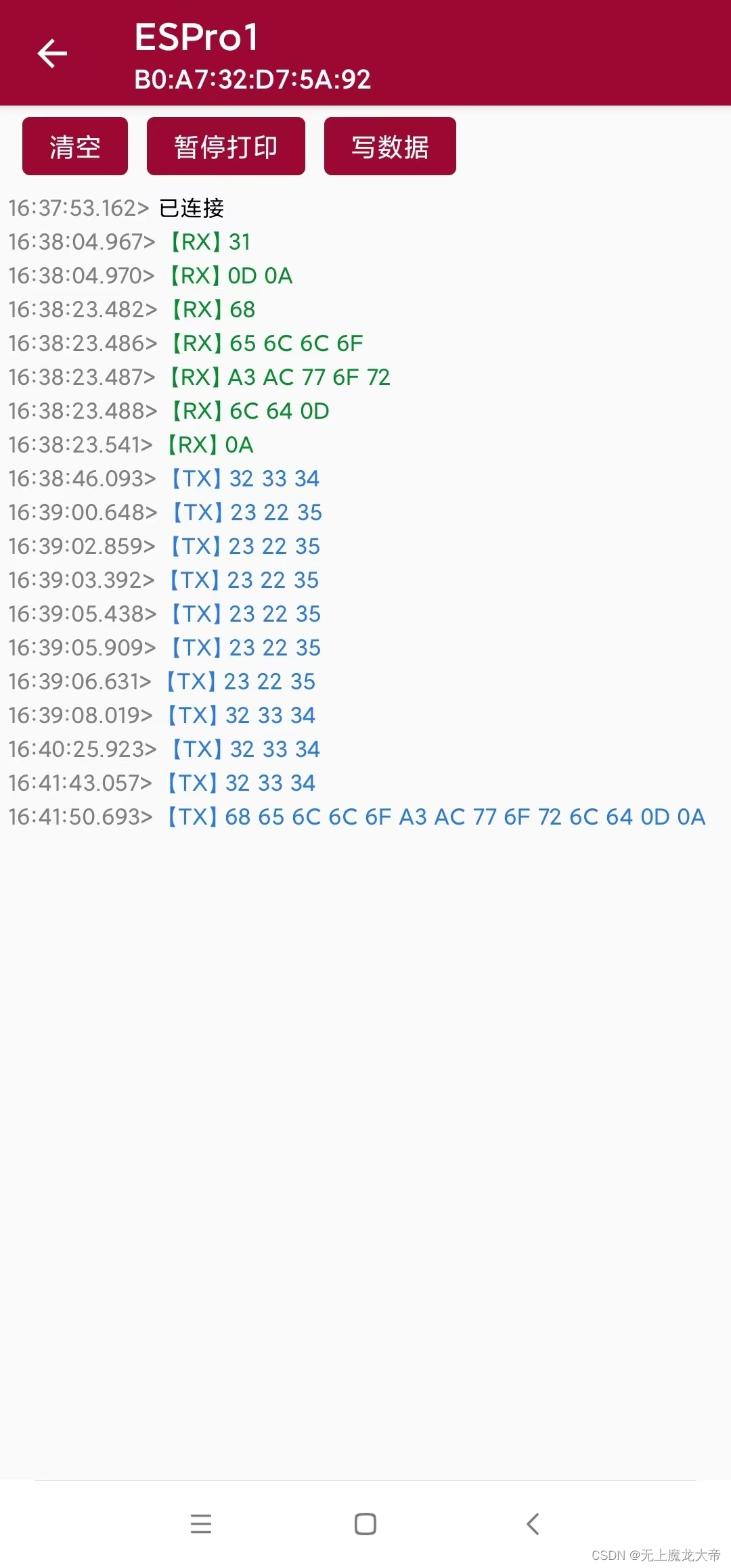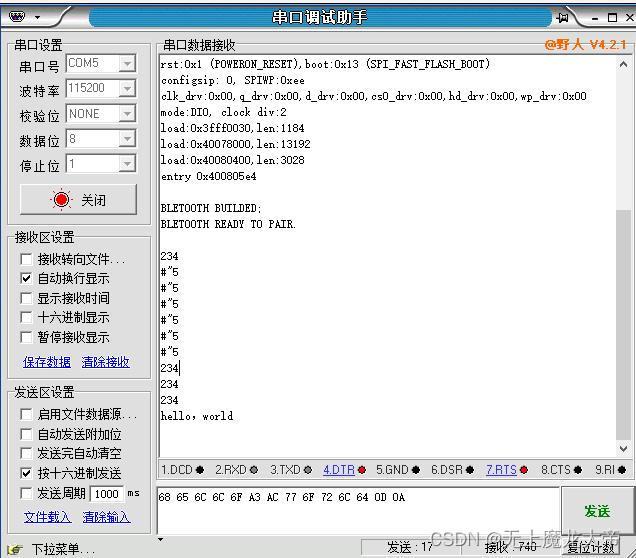这篇文章分成三个部分,第一个部分是对经典蓝牙的使用,第二部分是学习网上的低功耗蓝牙和他们的具体实现方法,第三个部分对学习到的做一个反馈,我们自己写一个低功耗蓝牙的程序。
一、经典蓝牙:
先放结果:


代码:
#include <Arduino.h>
#include <BluetoothSerial.h>
#include "userconmmon.h"
BluetoothSerial SerialBLUE;
void BLUETOOTH_EVENT()
{
}
void setup()
{
long lRetVal = -1;
Serial.begin(115200);
if(SerialBLUE.begin(SSID_NAME) )
{Serial.print("BLETOOTH BUILDED;\r\n");}
else
{ERR_PRINT("ERROR_BLETOOTH_BEGIN\r\n");}
SerialBLUE.setPin("1234");
Serial.printf("BLETOOTH READY TO PAIR. \r\n");
}
void loop()
{
if (Serial.available())
{
SerialBLUE.write(Serial.read());
}
if (SerialBLUE.available())
{
Serial.write(SerialBLUE.read());
}
delay(1);
}
二、低功耗蓝牙
看了些b站up主的讲解,对比了下CSDN上大佬们的文章,我找到了一份特别适合拿来学习低功耗蓝牙的文章。
文章来源于b站up主“homepea”,视频链接:【ESP32超详细教程-使用VSCode(基于Arduino框架)-哔哩哔哩】 https://b23.tv/6WNLBpX
(up主说资源也是他参考着找的,这里我就不追溯了,先直接拿来学习(手动狗头))
up主给的让我们学习的代码如下:
/*
Video: https://www.youtube.com/watch?v=oCMOYS71NIU
Based on Neil Kolban example for IDF: https://github.com/nkolban/esp32-snippets/blob/master/cpp_utils/tests/BLE%20Tests/SampleNotify.cpp
Ported to Arduino ESP32 by Evandro Copercini
Create a BLE server that, once we receive a connection, will send periodic notifications.
创建一个BLE服务器,一旦我们收到连接,将会周期性发送通知
T使用步骤:
1. 创建一个 BLE Server
2. 创建一个 BLE Service
3. 创建一个 BLE Characteristic
4. 创建一个 BLE Descriptor
5. 开始服务
6. 开始广播
*/
#include <Arduino.h>
#include <BLEDevice.h>
#include <BLEServer.h>
#include <BLEUtils.h>
#include <BLE2902.h>
#include "common.h"
uint8_t txValue = 0;
BLEServer *pServer = NULL; //BLEServer指针 pServer
BLECharacteristic *pTxCharacteristic = NULL; //BLECharacteristic指针 pTxCharacteristic
bool deviceConnected = false; //本次连接状态
bool oldDeviceConnected = false; //上次连接状态
// See the following for generating UUIDs: https://www.uuidgenerator.net/
#define SERVICE_UUID "12a59900-17cc-11ec-9621-0242ac130002" // UART service UUID
#define CHARACTERISTIC_UUID_RX "12a59e0a-17cc-11ec-9621-0242ac130002"
#define CHARACTERISTIC_UUID_TX "12a5a148-17cc-11ec-9621-0242ac130002"
class MyServerCallbacks : public BLEServerCallbacks
{
void onConnect(BLEServer *pServer)
{
deviceConnected = true;
};
void onDisconnect(BLEServer *pServer)
{
deviceConnected = false;
}
};
class MyCallbacks : public BLECharacteristicCallbacks
{
void onWrite(BLECharacteristic *pCharacteristic)
{
std::string rxValue = pCharacteristic->getValue(); //接收信息
if (rxValue.length() > 0)
{ //向串口输出收到的值
Serial.print("RX: ");
for (int i = 0; i < rxValue.length(); i++)
Serial.print(rxValue[i]);
Serial.println();
}
}
};
void setup()
{
Serial.begin(115200);
// 创建一个 BLE 设备
BLEDevice::init("UART_BLE");
// 创建一个 BLE 服务
pServer = BLEDevice::createServer();
pServer->setCallbacks(new MyServerCallbacks()); //设置回调
BLEService *pService = pServer->createService(SERVICE_UUID);
// 创建一个 BLE 特征
pTxCharacteristic = pService->createCharacteristic(CHARACTERISTIC_UUID_TX, BLECharacteristic::PROPERTY_NOTIFY);
pTxCharacteristic->addDescriptor(new BLE2902());
BLECharacteristic *pRxCharacteristic = pService->createCharacteristic(CHARACTERISTIC_UUID_RX, BLECharacteristic::PROPERTY_WRITE);
pRxCharacteristic->setCallbacks(new MyCallbacks()); //设置回调
pService->start(); // 开始服务
pServer->getAdvertising()->start(); // 开始广播
Serial.println(" 等待一个客户端连接,且发送通知... ");
}
void loop()
{
// deviceConnected 已连接
if (deviceConnected)
{
pTxCharacteristic->setValue(&txValue, 1); // 设置要发送的值为1
pTxCharacteristic->notify(); // 广播
txValue++; // 指针地址自加1
delay(2000); // 如果有太多包要发送,蓝牙会堵塞
}
// disconnecting 断开连接
if (!deviceConnected && oldDeviceConnected)
{
delay(500); // 留时间给蓝牙缓冲
pServer->startAdvertising(); // 重新广播
Serial.println(" 开始广播 ");
oldDeviceConnected = deviceConnected;
}
// connecting 正在连接
if (deviceConnected && !oldDeviceConnected)
{
// do stuff here on connecting
oldDeviceConnected = deviceConnected;
}
}话不多说,我们直接开始学习。
(1)首先看set up:
BLEDevice::init("UART_BLE"):这里的话我们只需要写我们自己蓝牙名字就好了。
static void init(std::string deviceName); // Initialize the local BLE environment.这是第二段:
// 创建一个 BLE 服务
pServer = BLEDevice::createServer();
pServer->setCallbacks(new MyServerCallbacks()); //设置回调
BLEService *pService = pServer->createService(SERVICE_UUID);creatServer用于创建一个新服务器:
/**
* @brief Create a new instance of a server.
* @return A new instance of the server.
*/
/* STATIC */ BLEServer* BLEDevice::createServer() {
log_v(">> createServer");
#ifndef CONFIG_GATTS_ENABLE // Check that BLE GATTS is enabled in make menuconfig
log_e("BLE GATTS is not enabled - CONFIG_GATTS_ENABLE not defined");
abort();
#endif // CONFIG_GATTS_ENABLE
m_pServer = new BLEServer();
m_pServer->createApp(m_appId++);
log_v("<< createServer");
return m_pServer;
} // createServerBLEServer::BLEServer() {
m_appId = ESP_GATT_IF_NONE;
m_gatts_if = ESP_GATT_IF_NONE;
m_connectedCount = 0;
m_connId = ESP_GATT_IF_NONE;
m_pServerCallbacks = nullptr;
} // BLEServervoid BLEServer::createApp(uint16_t appId) {
m_appId = appId;
registerApp(appId);
} // createApp建立好服务器后,设置回调:
/**
* @brief Set the server callbacks.
*
* As a %BLE server operates, it will generate server level events such as a new client connecting or a previous client
* disconnecting. This function can be called to register a callback handler that will be invoked when these
* events are detected.
*
* @param [in] pCallbacks The callbacks to be invoked.
*/
void BLEServer::setCallbacks(BLEServerCallbacks* pCallbacks) {
m_pServerCallbacks = pCallbacks;
} // setCallbacks然乎利用UUID创建服务:
/**
* @brief Create a %BLE Service.
*
* With a %BLE server, we can host one or more services. Invoking this function causes the creation of a definition
* of a new service. Every service must have a unique UUID.
* @param [in] uuid The UUID of the new service.
* @return A reference to the new service object.
*/
BLEService* BLEServer::createService(const char* uuid) {
return createService(BLEUUID(uuid));
}
这里这样写是因为GATT。 GATT是BLE通信规定,每个设备中存在许多service,包含很多个characteristic。(不准确)地说,ESP32是BLEDevice,建立一个BLEServer,每一个BLE服务器中有多个服务BLEservice,服务里又有许多BLECharacteristic,读写这些数据可以实现数据交换。
如果一个主机的特征值改变,发送通知notify告诉客户端,而这句话,就是在创建特征值的时候,将他规定成通知类型,这个特征值变化了,我就通知客户端。
// 创建一个 BLE 特征
pTxCharacteristic = pService->createCharacteristic(CHARACTERISTIC_UUID_TX, BLECharacteristic::PROPERTY_NOTIFY);
pTxCharacteristic->addDescriptor(new BLE2902());
BLECharacteristic *pRxCharacteristic = pService->createCharacteristic(CHARACTERISTIC_UUID_RX, BLECharacteristic::PROPERTY_WRITE);
pRxCharacteristic->setCallbacks(new MyCallbacks()); //设置回调关于creatCharacteristic,他传递两个参数,分别是特征值的UUID和特征值的属性。
/**
* @brief Create a new BLE Characteristic associated with this service.
* @param [in] uuid - The UUID of the characteristic.
* @param [in] properties - The properties of the characteristic.
* @return The new BLE characteristic.
*/
BLECharacteristic* BLEService::createCharacteristic(const char* uuid, uint32_t properties) {
return createCharacteristic(BLEUUID(uuid), properties);
}特征值的属性有以下几种:

设置好属性后,将描述符与此特征值关联。传递参数是UUID描述符
/**
* @brief Associate a descriptor with this characteristic.
* @param [in] pDescriptor
* @return N/A.
*/
void BLECharacteristic::addDescriptor(BLEDescriptor* pDescriptor) {
log_v(">> addDescriptor(): Adding %s to %s", pDescriptor->toString().c_str(), toString().c_str());
m_descriptorMap.setByUUID(pDescriptor->getUUID(), pDescriptor);
log_v("<< addDescriptor()");
} // addDescriptor然后这里的特征值有tx和rx,应该是模仿串口。tx代表一个transport, rx代表一个receive。
所以下面是创建了一个接受数据的特征值并回调。
然后就是启动服务,
pService->start(); // 开始服务
pServer->getAdvertising()->start(); // 开始广播
Serial.println(" 等待一个客户端连接,且发送通知... ");这里用到了getAdvertising,它的作用是检索可用于服务器存在的广播对象。
返回值是广播对象。
/**
* @brief Retrieve the advertising object that can be used to advertise the existence of the server.
*
* @return An advertising object.
*/
BLEAdvertising* BLEServer::getAdvertising() {
return BLEDevice::getAdvertising();
}(2)然后开始看loop的部分,
loop第一部分需要关注的是
if (deviceConnected)
{
pTxCharacteristic->setValue(&txValue, 1); // 设置要发送的值为1
pTxCharacteristic->notify(); // 广播
txValue++; // 指针地址自加1
delay(2000); // 如果有太多包要发送,蓝牙会堵塞
}这里的deviceConnected初始化时是false,在set up()中创建BLE服务的时候,如果满足连接会被设置成true。
这个Delay(2000) 正如注释所说,是用来避免堵塞。
到这里今天的学习就结束了,明天可能做一些外设什么的,或者继续推进低功耗蓝牙,再说吧,最近考试周需要复习,还是慢慢搞比较好。
























 被折叠的 条评论
为什么被折叠?
被折叠的 条评论
为什么被折叠?








